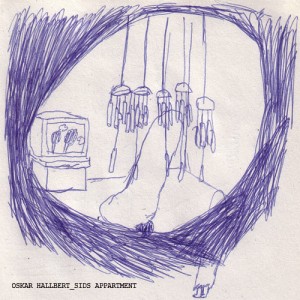Charles Rice Goff III
“Anthimerias”
Anthimerias
by Charles Rice Goff III
01 Engineer
02 Study
03 Style
04 Craft
05 Form
06 Design
Anthimeria: a word that is both a noun and a verb.
Anthimerias have become more and more ubiquitous as human linguistics have evolved throughout the early 21st Century.
The Process:
The recordings in this collection all started out as improvisations, played by Goff on a Casio AP-24 electric piano. This full-sized, 88 key piano was purchased from a Salvation Army store in Bonner Springs, Kansas, and appears to once have been employed to serve up the music for church services somewhere in the Kansas City area. Goff recorded his improvisations through the open-air microphones of a Canon S2 IS digital camera. By avoiding the use of direct line-in recording, all the overtones echoing from the piano’s speakers, some of the sounds of Goff’s fingers hitting the piano keys, and even some occasional squeaks of Goff’s chair are present in these recordings.
Using “AmazingMIDI” computer software, Goff converted each of these digital recordings into MIDI files. This particular software converts every bit of recorded data from a wave file into a monophonic MIDI format. The MIDI file then can be read by MIDI score-writing software, allowing all of its recorded sounds (including overtones and the noises of squeaking chairs) to appear as notation. Such score-writing software provides the means for artists to apply sounds from a wide variety of virtual (computer-generated) instruments to the MIDI notation. Score writers also allow artists to transpose musical keys, delete/add notation, copy and paste musical passages, add reverb and chorus effects, etc.
Goff used three different score-writers, programmed into three different computer operating systems, when molding the recordings for Anthimerias:
1) Midisoft Music Mentor MIDI Scorewriter (released 1994)
run on Microsoft Windows XP OS (2013)
2) Musescore MIDI Scorewriter (Version 1.1, released 2011)
run on Microsoft Windows 10 OS (2016)
3) Musescore MIDI Scorewriter (Version 3.6.2, released 2021)
run on Linux Ubuntu OS (2022)
Each of these three setups provided Goff with its own unique pallet of sounds and editing controls. Goff gradually refined his compositions by transferring partially-edited MIDI files from one setup to another, allowing him to alter the files again and again using all three sets of software parameters. He later re-converted his edited MIDI files into wave files and further orchestrated them with Cool Edit Pro 2.1 (released 2003) multitrack audio-editing software. During this final process, bits of the original, open-air Casio electric piano recordings were layered into some of the mixes as well. Thus, each Anthimerias composition features its own unique blend of instrumentation, dynamics, and overall attitude.
No material that did not originate from the Casio electric piano improvisations was added during the production of this collection. Some of the aforementioned overtones and incidental finger and chair noises did convert into MIDI notation, however. Several of these happy accidents were incorporated into the final mixes of this collection. No artificial intelligence was used in the production of Anthimerias.
To help listeners envision the composition process of Anthimerias, a printed PDF score of “Form” is included in this collection. This 265-page document was created through Musescore software after Goff had finished editing the piece.
Recording Dates Of Goff’s Original Casio Electric Piano Improvisations:
July 13, 2023 (Design)
September 14, 2023 (Engineer)
November 30, 2023 (Study, Craft, Form)
December 23, 2023 (Style)








